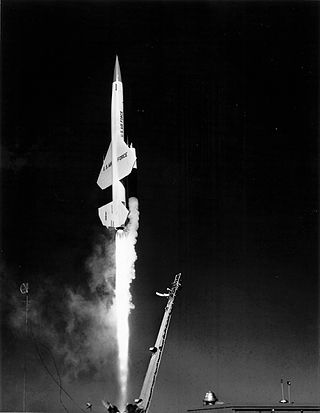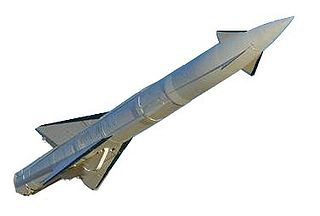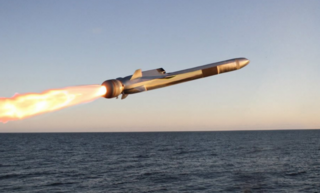The Hard Mobile Launcher(HML) is a mobile radiation-hardened truck transporter erector launcher designed to facilitate the transport and launching of the MGM-134 Midgetman missile. [1]
The Hard Mobile Launcher(HML) is a mobile radiation-hardened truck transporter erector launcher designed to facilitate the transport and launching of the MGM-134 Midgetman missile. [1]



It can travel at speeds of up to 55 mph (89 km/h) on the road and it also has off-road capabilities. The vehicle also has a trailer mounted plow which can be used to dig the launcher into the earth in order to help protect it were it within the vicinity of a nuclear detonation.
The vehicle weighs a total of 239,000 lb (108,000 kg), with a length of over 110 feet (34 m) and it has the capability to transport objects weighing up to 80,000 lb (36,000 kg). It is powered by a Rolls-Royce Perkins diesel engine which produces 1,200 hp (890 kW) and controls all 8 wheels using an electro-hydraulic transmission. [2]
Two teams were assigned to develop a vehicle.
Caterpillar developed a tracked tractor (Mobil-Trac System) while Martin Marietta was the system integrator and also built the Mobility Test Bed missile trailer. [3]
A second team consisting of Boeing Aerospace and Electronics' Loral Defense Systems Division (Goodyear Aerospace) built an eight wheel drive vehicle and trailer.
The Air Force selected the Boeing-Loral prototype. Several vehicles were delivered to the US Air Force by December 1986. The Air Force tested the vehicle until 1991, after which development of the MGM-134 missile project ceased, leading to the project's cancellation.
Following the cancellation of the MGM-134 missile project, the last of the engineering models was acquired by the National Museum of the U.S. Air Force in Ohio in 1992. It is no longer on display and was given to the Defense Reutilization and Marketing Office. [4]
The Hard Mobile Launcher at Wright Patterson Air Force Base was sold for scrap in July 2015. The lot number was 5650, the auction event ID was 40039. The event notice is still online as of October 2017. [5] It was broken up in September 2015.

The Boeing CIM-10 Bomarc was a supersonic ramjet powered long-range surface-to-air missile (SAM) used during the Cold War for the air defense of North America. In addition to being the first operational long-range SAM and the first operational pulse doppler aviation radar, it was the only SAM deployed by the United States Air Force.

A cruise missile is an unmanned self-propelled guided vehicle that sustains flight through aerodynamic lift for most of its flight path and whose primary mission is to place an ordnance or special payload on a target. Cruise missiles are designed to deliver a large warhead over long distances with high precision. Modern cruise missiles are capable of traveling at high subsonic, supersonic, or hypersonic speeds, are self-navigating, and are able to fly on a non-ballistic, extremely low-altitude trajectory.
The SM-65 Atlas was the first operational intercontinental ballistic missile (ICBM) developed by the United States and the first member of the Atlas rocket family. It was built for the U.S. Air Force by the Convair Division of General Dynamics at an assembly plant located in Kearny Mesa, San Diego.

The Boeing YAL-1 airborne laser testbed was a modified Boeing 747-400F with a megawatt-class chemical oxygen iodine laser (COIL) mounted inside. It was primarily designed to test its feasibility as a missile defense system to destroy tactical ballistic missiles (TBMs) while in boost phase. The aircraft was designated YAL-1A in 2004 by the U.S. Department of Defense.

The Boeing X-20 Dyna-Soar was a United States Air Force (USAF) program to develop a spaceplane that could be used for a variety of military missions, including aerial reconnaissance, bombing, space rescue, satellite maintenance, and as a space interceptor to sabotage enemy satellites. The program ran from October 24, 1957, to December 10, 1963, cost US$660 million, and was cancelled just after spacecraft construction had begun.

The PGM-19 Jupiter was the first nuclear armed, medium-range ballistic missile (MRBM) of the United States Air Force (USAF). It was a liquid-propellant rocket using RP-1 fuel and LOX oxidizer, with a single Rocketdyne LR79-NA rocket engine producing 667 kilonewtons (150,000 lbf) of thrust. It was armed with the 1.44 megatons of TNT (6.0 PJ) W49 nuclear warhead. The prime contractor was the Chrysler Corporation.
Blue Water was a British battlefield nuclear missile of the early 1960s, intended to replace the MGM-5 Corporal, which was becoming obsolete. With roughly the same role and range as Corporal, the solid-fuel Blue Water was far simpler to use and would be significantly easier to support in the field. It was seen as a replacement for Corporal both in the UK as well as other NATO operators, notably Germany and possibly Turkey.

The MGR-1 Honest John rocket was the first nuclear-capable surface-to-surface rocket in the United States arsenal. Originally designated Artillery Rocket XM31, the first unit was tested on 29 June 1951, with the first production rounds delivered in January 1953. Its designation was changed to M31 in September 1953. The first Army units received their rockets by year's end and Honest John battalions were deployed in Europe in early 1954. Alternatively, the rocket was capable of carrying an ordinary high-explosive warhead weighing 1,500 pounds (680 kg).

Israel Aerospace Industries, is Israel's major aerospace and aviation manufacturer, producing aerial and astronautic systems for both military and civilian usage. It has 14,000 employees as of 2021. IAI is state-owned by the government of Israel.

The Hughes AIM-47 Falcon, originally GAR-9, was a very long-range high-performance air-to-air missile that shared the basic design of the earlier AIM-4 Falcon. It was developed in 1958 along with the new Hughes AN/ASG-18 radar fire-control system intended to arm the Mach 3 XF-108 Rapier interceptor aircraft and, after that jet's cancellation, the YF-12A. It was never used operationally, but was a direct predecessor of the AIM-54 Phoenix used on the Grumman F-14 Tomcat.

The Avenger Air Defense System, designated AN/TWQ-1 under the Joint Electronics Type Designation System, is an American self-propelled surface-to-air missile system which provides mobile, short-range air defense protection for ground units against cruise missiles, unmanned aerial vehicles, low-flying fixed-wing aircraft, and helicopters.

The Martin MGM-1 Matador was the first operational surface-to-surface cruise missile designed and built by the United States. It was developed after World War II, drawing upon their wartime experience with creating the Republic-Ford JB-2, a copy of the German V-1. The Matador was similar in concept to the V-1, but it included a radio command that allowed in-flight course corrections. This allowed accuracy to be maintained over greatly extended ranges of just under 1000 km. To allow these ranges, the Matador was powered by a small turbojet engine in place of the V-1's much less efficient pulsejet.
The Hsiung Feng IIE is a surface-to-surface land-attack cruise missile system developed by the National Chung-Shan Institute of Science and Technology (NCSIST) in Taiwan.

The Roland is a Franco-German mobile short-range surface-to-air missile (SAM) system. The Roland was also purchased by the U.S. Army as one of very few foreign SAM systems.

The Naval Strike Missile (NSM) is an anti-ship and land-attack missile developed by the Norwegian company Kongsberg Defence & Aerospace (KDA).
The AGM-153 was a missile considered for development by the United States.

The MGM-134A Midgetman, also known as the Small Intercontinental Ballistic Missile, was an intercontinental ballistic missile developed by the United States Air Force. The system was mobile and could be set up rapidly, allowing it to move to a new firing location after learning of an enemy missile launch. To attack the weapon, the enemy would have to blanket the area around its last known location with multiple warheads, using up a large percentage of their force for limited gains and no guarantee that all of the missiles would be destroyed. In such a scenario, the U.S. would retain enough of their forces for a successful counterstrike, thereby maintaining deterrence.

The Boeing NC-135 and NKC-135 are special versions of the Boeing C-135 Stratolifter and Boeing KC-135 Stratotanker modified to operate on several different programs.

A high-altitude platform station also known as atmospheric satellite is a long endurance, high altitude aircraft able to offer observation or communication services similarly to artificial satellites. Mostly unmanned aerial vehicles (UAVs), they remain aloft through atmospheric lift, either aerodynamic like airplanes, or aerostatic like airships or balloons. High-altitude long endurance (HALE) military drones can fly above 60,000 ft over 32 hours, while civil HAPS are radio stations at an altitude of 20 to 50 km above waypoints, for weeks.

The Boeing CQM-121 Pave Tiger was an unmanned aerial vehicle developed by Boeing for use by the United States Air Force. Intended for the Suppression of Enemy Air Defenses (SEAD) role, the drone reached the flight-test stage before cancellation.